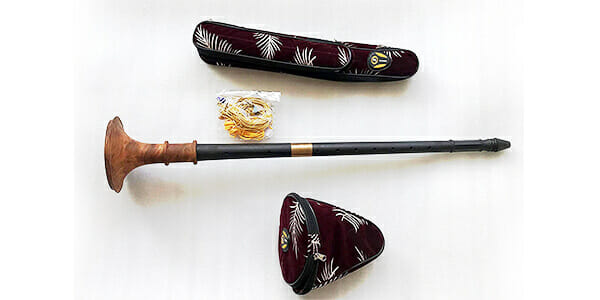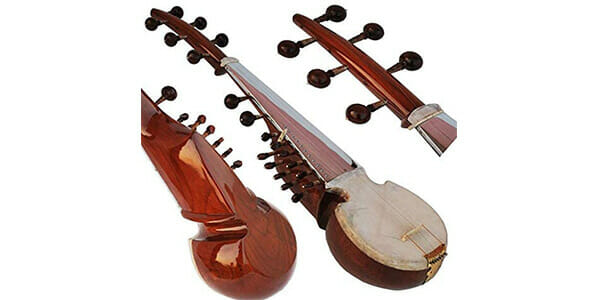
India is a country with a rich culture and incredible musical talent. The Indian classical music is starkly different from western music, with sophisticated Ragas and Taals forming a strong foundation of any artist’s performance.
Two genres are recognized under the Indian classical music form. The Hindustani classical music hails from northern India and the Carnatic classical music belongs to southern India. There is a lot of emphasis on harmony and melody when it comes to musical instruments in both these music streams. In fact, musical instruments used in folk music and devotional music also place a huge significance on harmony and rhythm.
Let us get some insight on these melodious musical instruments from India and their cultural and social significance.
Table of Contents
- 1. Bansuri
- 2. Nadaswaram
- 3. Harmonium
- 4. Santoor
- 5. Tabla
- 6. Sarod
- 7. Shankh
- 8. Sitar
- 9. Swarmandal
- 10. Veena
1. Bansuri

The Bansuri is a traditional Indian flute, played in classical as well as folk music genres. While transverse flutes are most commonly played in the Indian classical music form, vertical flutes can be seen with the folk music performers.
The word Bansuri literally translates to “musical notes of bamboo“. Quite a few regional versions of Bansuris exist in India since these are mostly hand-made with locally sourced bamboo. The handcrafted element makes each Bansuri stand out in its craftsmanship.
The Bansuri yields a beautiful melodious tune and is used in solo performances as well as in orchestras, stage events and dance performances. The Bansuri has also gained significance in Indian devotional music and Bhajans. It is revered as sacred and associated with the Hindu deity Lord Krishna.
2. Nadaswaram

The Nadaswaram is a popular wind instrument from south India. The word Nadaswaram is derived from the root words, “nada” which means soothing and “swaram” which means sound. Indeed, the Nadaswaram has a very pleasant sound and is regarded very solemnly. It is often played during religious festivities and temple offerings. The Nadaswaram is often accompanied by drums and other musical instruments.
The instrument is made of wood or metal and resembles a clarinet. There are seven finger holes along the tubular body. It is believed that aged wood is best suited for making a Nadaswaram. It is regarded as a complex instrument and the player requires thorough breath control and skill to play it well.
3. Harmonium

The Harmonium is a piano-like instrument, believed to have been adapted from the design of a reed organ. The instrument evolved in the Indian music culture during the British rule and has since then been widely embraced in all music forms.
You can hear the Harmonium being played at temple concerts, classical musical performances and social events. It often acts as a lead instrument in singing and dancing performances, and used for giving cues to the performer. The instrument is played with equal fervor across all religious and traditions in India.
4. Santoor

The Santoor is a unique Indian musical instrument which is predominantly played in the state of Jammu and Kashmir. It is believed that the Santoor is an adaptation of a Mesopotamian musical instrument.
The instrument is made of a wooden sound box with 100 strings stretched across 25 bridges. The player sits with the instrument on his lap and using special wooden mallets gently strokes at the strings. The Santoor is mainly played in Hindustani classical musical performances.
5. Tabla

The Tabla is the most widely used percussion instrument in the Indian subcontinent. It may be impossible to feature the Indian classical music without the Tabla.
The instrument consists of a pair of small drums which are placed before the performer on the floor. The player sits on the floor across the Tabla in a cross-legged position and taps at the drum-heads using his palm and fingers. The drum on the left -hand of the player is broad and bigger and yields a low tone, while the drum on the right-hand is narrow and small and plays high tones.
The Tabla is usually played alongside other instruments and during classical dance performances to give beat and rhythm. But it is not uncommon to see maestros playing the Tabla at solo performances.
6. Sarod

The Sarod is a fretless stringed instrument from the Indian classical music genre that resembles a lute. It has two resonators, one at the bottom and one that is affixed to the tapered end of the neck. The body is made of a single block of wood. There are a total of 25 strings on the Sarod out of which five are mainly for melody and the remaining ones are sympathetic strings.
The Sarod is known for its deep melodious notes and is often played in classical solo performances. The instrument is rather difficult to learn and master.
7. Shankh

The Shankh is a rather primitive Indian musical instrument and is in essence a conch shell. It is made of the shell of a large predatory aquatic snail. The Shankha is considered sacred in the Hindu religion and played at religious ceremonies and on auspicious occasions.
It is also associated with Buddhist traditions and rituals. It is believed that the loud deep sound from the Shankha resonates the holy chanting of “Om“. The Shanka was also given military significance in ancient India during war times.
8. Sitar

The Sitar is an Indian musical instrument that has gained world recognition owing to the spectacular performances of maestros like Pandit Ravi Shankar.
It is a rather long lute with 20 metal frets, 7 main cords and 13 sympathetic strings. Just like the Sarod, it has two resonators. A large gourd-shaped resonator is present at the bottom and the smaller one is present at the top-end of the neck.
It has a pleasant melodious sound that has become so popular that it has been played by celebrated western music artists, namely the Beatles and Led Zepplin.
9. Swarmandal

The Swarmandal is another Indian musical instrument that has been recognized with world fame, and the credit goes to the Beatles. Traditionally, the Swarnmandal is played in the classical Hindustani vocal music alongside the vocal artist. Usually, the lead vocal artist plays the instrument himself. The strings on the instrument can range from 21 to 36 in number and create a wide spectrum of musical notes to match the singer’s voice and pitch.
10. Veena

Historians regard the Veena as one of the oldest Indian musical instruments. It is believed that the origin of the Veena dates back to the 2nd century. It is a large stringed instrument with a huge bowl-shaped resonator. The performer has to sit with the Veena on the floor by his right side. The neck of the Veena rests on the shoulder of the player, while he tunes the strings and plucks at them with the other hand.
Two types of Veena are popularly played in the Indian classical music genres, namely the Saraswati Veena and the Rudra Veena.

